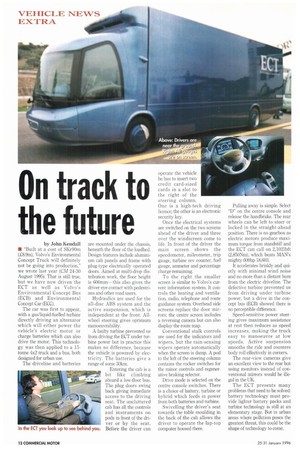On track to the future
Page 14

If you've noticed an error in this article please click here to report it so we can fix it.
by John Kendall
• "Built at a cost of SKr90m (008.9m), Volvo's Environmental Concept Truck will definitely not be going into production," we wrote last year (CM 24-30 August 1995). That is still true, but we have now driven the ECT as well as Volvo's Environmental Concept Bus (ECB) and Environmental Concept Car (ECC).
The car was first to appear, with a gas/liquid-fuelled turbine directly driving an alternator which will either power the vehicle's electric motor or charge batteries which can also drive the motor. This technology was then applied to a 15tonne 4x2 truck and a bus, both designed for urban use.
The driveline and batteries are mounted under the chassis, beneath the floor of the loadbed. Design features include aluminium cab panels and frame with plug-type electrically operated doors. Aimed at multi-drop distribution work, the floor height is 600mm—this also gives the driver eye contact with pedestrians and other road users.
Hydraulics are used for the all-disc ABS system and the active suspension, which is independent at the front. Allwheel steering gives optimum manoeuvrability.
A faulty turbine prevented us from driving the ECT under turbine power but in practice this makes no difference, because the vehicle is powered by electricity. The batteries give a range of some 30km.
Entering the cab is a bit like climbing aboard a low-floor bus. The plug doors swing back giving immediate access to the driving seat. The uncluttered cab has all the controls and instruments on pods in front of the driver or by the seat. Before the driver can operate the vehicle he has to insert two credit card-sized cards in a slot to the right of the steering column. One is a high-tech driving licence; the other is an electronic security key.
Once the electrical systems are switched on the two screens ahead of the driver and three over the windscreen come to life. In front of the driver the main screen shows the speedometer, mileometer, trip gauge, turbine rev counter, fuel gauge, ammeter and percentage charge remaining.
To the right the smaller screen is similar to Volvo's current information system. It controls the heating and ventilation, radio, telephone and route guidance system. Overhead side screens replace the door mirrors; the centre screen includes a reversing camera but can also display the route map.
Conventional stalk controls are used for the indicators and wipers, but the rain-sensing wipers operate automatically when the screen is damp. A pod to the left of the steering column contains the rocker switches for the minor controls and regenerative braking selector.
Drive mode is selected on the centre console switches. There is a choice of battery, turbine or hybrid which feeds in power from both batteries and turbine.
Swivelling the driver's seat towards the table moulding in the back of the cab allows the driver to operate the lap-top computer housed there. Pulling away is simple. Select on the centre console and release the handbrake. The rear wheels can be left to steer or locked in the straight-ahead position. There is no gearbox as electric motors produce maximum torque from standstill and the ECT can call on 2,102Ibft (2,850Nm), which beats IVIAN's mighty 600hp 18.603.
It accelerates briskly and quietly with minimal wind noise and no more than a distant hum from the electric driveline. The defective turbine prevented us from driving under turbine power, but a drive in the concept bus (ECB) showed there is no perceptible difference.
Speed-sensitive power steering gives maximum assistance at rest then reduces as speed increases, making the truck easy to manoeuvre at low speeds. Active suspension smooths the ride and counters body roll effectively in corners.
The rear-view cameras give an excellent view to the rear but using monitors instead of conventional mirrors would be illegal in the UK.
The ECT presents many problems that need to be solved: battery technology must provide lighter battery packs and turbine technology is still at an elementary stage. But in urban areas where pollution poses the greatest threat, this could be the shape of technology to come.
































































































